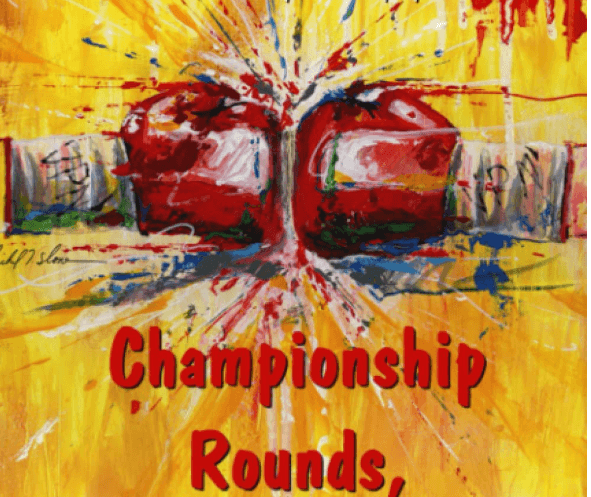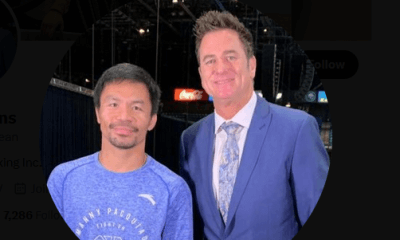Book Review
Literary Notes from Thomas Hauser

Literary Notes from Thomas Hauser
Bernard Fernandez has written thousands of articles during his 55-year career as a sports journalist. Championship Rounds: Round 5 is the fifth (and Bernard says, the last) collection of his articles to be published in book form.
Fernandez has a way with words. He also has an ear for quotes as evidenced by the following thoughts from Championship Rounds: Round 5:
Alex Rodriguez (speaking about his brother, Francisco, who died after being knocked out by Teon Kennedy at the Blue Horizon in Philadelphia): “My brother had a perfect heart, perfect lungs, perfect kidneys, perfect pancreas. Because of him, other people will have a chance for better health, more birthdays, the fulfillment of their own dreams. Paco is going to continue walking through this world through them.”
Johnny Tapia (after Don King completely dominated the final prefight press conference for his fight against Nana Yaw Konadu in Atlantic City): “I don’t understand this. I mean, I’m the one who’s fighting, right?”
Archie Moore: “A legend is something between fact and fable. Some people might say that that is an accurate description of me.”
George Foreman (on Roy Jones): “The better he is at his craft, the less people understand it.”
Mike Tyson (on Sonny Liston’s gift for weakening opponents through intimidation): “He was a menacing force. Sonny could pull it off. I could pull it off. Not a lot of people could pull it off.”
Bert Sugar (reflecting on some of the unsavory characters who have been inducted into the International Boxing Hall of Fame): “You can always make a case for someone’s exclusion. It depends on how moralistic you want to be. But remember, this is boxing we’re talking about.”
Ferdie Pacheco (after watching 47-year-old Roberto Duran get knocked out by William Joppy in three rounds): “What happened tonight happens too often in boxing. How often do we need to see Joe Louis knocked out by Rocky Marciano, Muhammad Ali beaten to a pulp by Larry Holmes, Sugar Ray Robinson losing to everybody? How much longer do we need to see these legends take beatings like this? This wasn’t a boxing match. It was a licensed execution. I hope it’s the end of the line for Roberto. It should have been the end of the line ten years ago.”
Seth Abraham (reflecting on having signed Roy Jones to a multi-bout contract with insufficient quality control regarding opponents): “In retrospect, I wish I had taken a harder line with him. He wanted to make the most money. That’s fine. He wanted to take the fewest risks. That’s not fine if you want the most money.”
Matthew Saad Muhammad (on his hyper-aggressive ring style and growing older): “You can’t fight the way I did unless you got something to back it up. I couldn’t back it up anymore.”
Archie Moore. “Boxing is magnificent. It’s beautiful to know. But you’ve got to marry it. And so I did. Boxing was my lover. It was my lady.”
Earnie Shavers (on knocking Larry Holmes down and near-senseless with an overhand right. Miraculously, Holmes rose from the canvas and, four rounds later, knocked Shavers out): “I was the heavyweight champion of the world. All my troubles were finally over. It was the greatest feeling I’d ever had. And it lasted for five whole seconds.”
Dan Goossen (on Michael Nunn leaving him for a new manager): “Am I hurt that he decided to leave me? Of course. It’s kind of like being married to a beautiful woman. Guys are going to whistle at her, try to pick her up. It’s up to her to do the right thing and come home. Same thing with Michael. People are going to constantly hit on him. This time, he didn’t come home.”
* * *
Women’s boxing peaked with Katie Taylor vs. Amanda Serrano at Madison Square Garden on April 30, 2022. It was a superb fight between two skilled fighters in an atmosphere that was electric. In Malissa Smith’s words, that night “set the stage for a new era of elite female boxing” and “legitimized” women’s boxing.
Six months later, Claressa Shields and Savannah Marshall squared off at the O2 Arena in London with Mikaela Mayer vs. Alycia Baumgardner on the undercard. Like Taylor-Serrano, the fights in London were a platform for women’s boxing to build on.
Smith’s new book – The Promise of Women’s Boxing (Rowman & Littlefield) – focuses on women’s boxing from the 2012 Olympics to date and is a sequel to her first book – A History of Women’s Boxing (published a decade ago).
Smith has put a huge amount of research into her work. But she recites the details of fight after fight after fight. After a while, the fights tend to blur together and reading about them feels like reading a 224-page encyclopedia article.
Also, when Smith’s writing isn’t too dry, it tends toward hyperbole. Words like “great” and “spectacular” are overused . . . Amanda Serrano is a very good boxer. She is not “one of the hardest-hitting fighters in boxing, male or female.” (Amanda’s last seven opponents have gone the distance against her) . . . And as good a fight as Taylor-Serrano was, it was not “one of the greatest boxing matches in the history of the sport.”
Here, the thoughts of promoter Lou DiBella are instructive. As recounted by Smith, DiBella cautions that fans should “stop comparing women’s boxing contests to men’s and start appreciating them on their own terms.”
* * *
Every fighter has a story. And every fighter’s story is interesting. But some fighters’ stories are more interesting and more artfully told than others.
Land of Hope and Glory by Maurice Hope with Ron Shillingford (Pitch Publishing) has some worthwhile moments but falls short of the mark.
Hope (30-4-1, 24 KOs, 2 KOs by) fought professionally from 1973 through 1982. The high point of his career came in 1979 when he stopped Italian-born Rocky Mattioli in San Remo to claim the WBC 154-pound title. Two years later, he lost his belt to Wilfred Benitez.
The loss to Benitez ended with a frightening highlight-reel knockout that left Hope unconscious on the canvas for an extended period of time. In an ugly coda, when Wilfred was told that Maurice had lost two teeth in the battle, Wilfred responded, “He can put the teeth under his pillow.”
There are some entertaining passages in Land of Hope and Glory. Recounting the prelude to his championship-winning fight against Mattioli, Hope recalls, “Walking to the ring was frightening. Shady figures in the crowd in dark suits and sunglasses were walking around with hands on their breast pockets. Whether there was just a handkerchief there or a loaded gun, the impact had the desired effect – intimidation. I pretended not to see them but it was hard to stay focused and calm. Gangsters with bandages around their hands seemed to be everywhere. It seemed like the Mafia had taken over the whole venue.”
There are also poignant recountings of the death of Hope’s son in a car accident and Maurice visiting a horribly disabled Wilfred Benitez in Puerto Rico long after Wilfred had descended into a hellish dementia.
But sixty pages pass before Land of Hope and Glory gets to a boxing gym. Hope doesn’t turn pro until page 93. And overall, the treatment of boxing is superficial. The book doesn’t explain with nuance or in depth what’s involved in being a fighter or what the business of boxing is about.
There are too many factual errors. For example, Las Vegas is described as being “in the middle of the Arizona desert.” And there’s some fuzzy math. Hope complains about an 80-79 decision that he lost to Mickey Flynn, writing, “The 80-79 decision meant Flynn won two rounds and the other six were draws.” That leads to two thoughts; (1) It’s more likely that Flynn won one round with seven rounds being called even; and (2) Since Maurice was the A-side fighter in that bout and Flynn had thirteen losses on his record, one might speculate that referee Benny Caplan (who was the sole judge) leaned over backward in Maurice’s favor and marked his scorecard “10-10” for rounds that Flynn should have won.
To his credit, Hope got out of boxing at the right time. After losing to Benitez and in his next fight to Luigi Minchillo, he retired from the ring at age thirty. He understood the risks of the trade he had chosen and now writes, “In my mind, boxing is the hardest sport out there. Once you get in the ring, you know your head’s going to hurt.”
Thomas Hauser’s email address is thomashauserwriter@gmail.com. His most recent book – MY MOTHER and me – is a memoir available at Amazon.com. https://www.amazon.com/My-Mother-Me-Thomas-Hauser/dp/1955836191/ref=sr_1_1?crid=5C0TEN4M9ZAH&keywords=thomas+hauser&qid=1707662513&sprefix=thomas+hauser%2Caps%2C80&sr=8-1
In 2004, the Boxing Writers Association of America honored Hauser with the Nat Fleischer Award for career excellence in boxing journalism. In 2019, Hauser was selected for boxing’s highest honor – induction into the International Boxing Hall of Fame.
To comment on this story in the Fight Forum CLICK HERE
-

 Featured Articles3 weeks ago
Featured Articles3 weeks agoVito Mielnicki Jr Whitewashes Kamil Gardzielik Before the Home Folks in Newark
-

 Featured Articles4 days ago
Featured Articles4 days agoResults and Recaps from New York Where Taylor Edged Serrano Once Again
-

 Featured Articles1 week ago
Featured Articles1 week agoFrom a Sympathetic Figure to a Pariah: The Travails of Julio Cesar Chavez Jr
-

 Featured Articles3 days ago
Featured Articles3 days agoResults and Recaps from NYC where Hamzah Sheeraz was Spectacular
-

 Featured Articles4 weeks ago
Featured Articles4 weeks agoCatching Up with Clay Moyle Who Talks About His Massive Collection of Boxing Books
-

 Featured Articles1 week ago
Featured Articles1 week agoCatterall vs Eubank Ends Prematurely; Catterall Wins a Technical Decision
-

 Featured Articles4 days ago
Featured Articles4 days agoPhiladelphia Welterweight Gil Turner, a Phenom, Now Rests in an Unmarked Grave
-

 Featured Articles3 weeks ago
Featured Articles3 weeks agoMore Medals for Hawaii’s Patricio Family at the USA Boxing Summer Festival



















